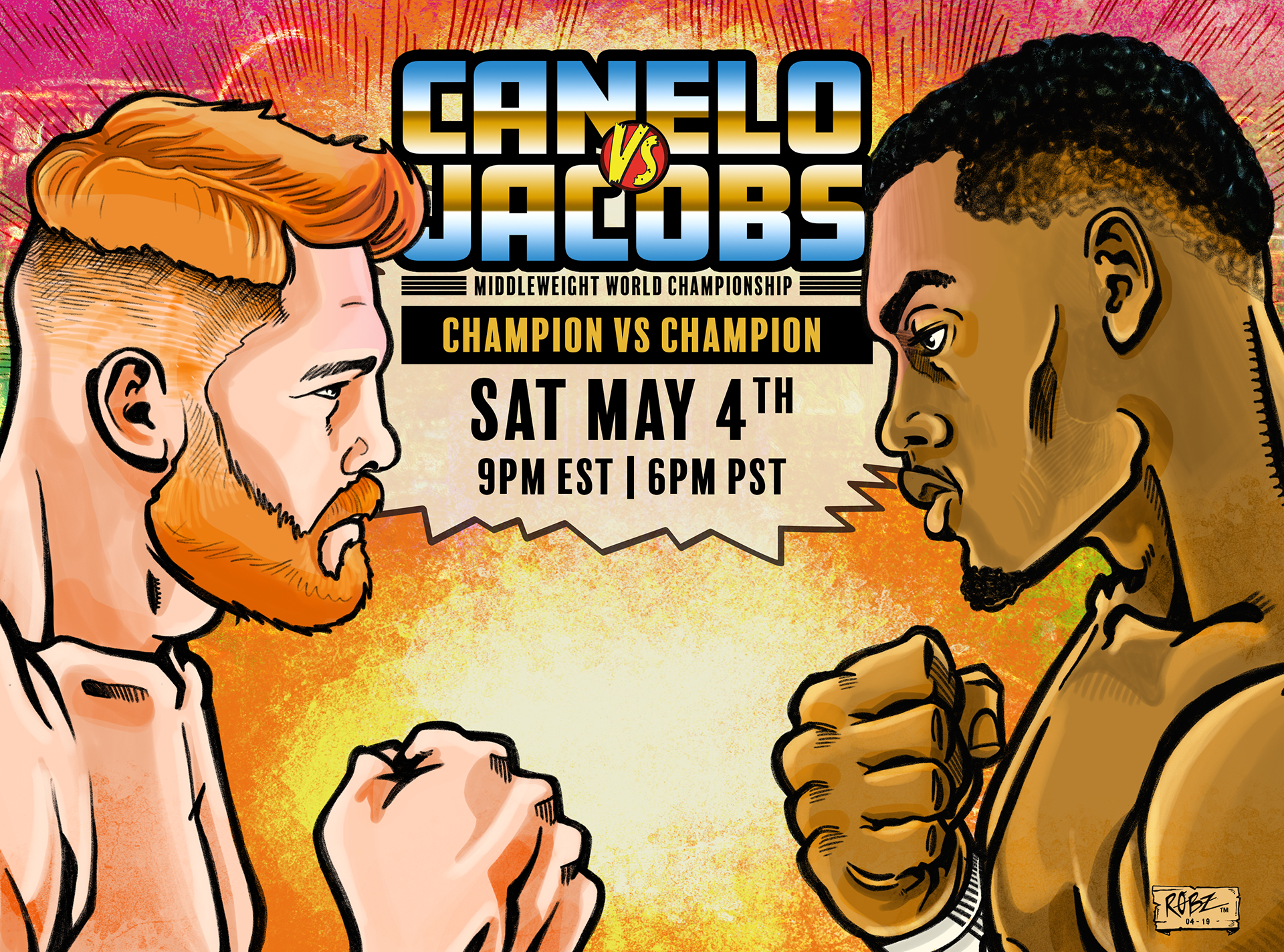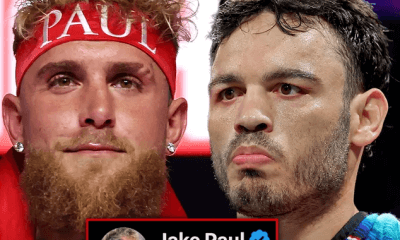Featured Articles
Who Will Win the Canelo-Jacobs Fight? 15 TSS Writers Give Their Picks

Mexican superstar Saul “Canelo” Alvarez and middleweight title-holder Daniel “Miracle Man” Jacobs collide on Saturday, May 4, at the T-Mobile Arena in Las Vegas. As is our custom whenever there is a mega-fight, we reached out to our community of writers to get their predictions. Our reach extended to our colleagues at our Spanish-language sister sites.
Predictably, there was a strong lean to Alvarez, the betting favorite, but Jacobs had his supporters and they made some provocative points.
Comic book cover artist ROB AYALA, whose specialty is combat sports, provided the graphic. Check out more of Rob Ayala’s illustrations at his web site fight posium.
The correspondents are listed alphabetically.
Gilda Aburto
A majority of people in the boxing business think Canelo will win, but Jacobs won’t be a piece of candy. Jacobs has a good defense, throws powerful combinations, he can fight in and out, and has proved he can go the distance. In order to win, Jacobs will have to pressure Canelo from the opening bell. Some say he doesn’t have a chance if the fight goes to the scorecards with the fight being held in Las Vegas, but JACOBS has everything that it takes to get a sound victory on Saturday.
J.J. Alvarez
Jacobs is taller, faster, stronger and has superior movement inside the ring. But his skills may be receding. In his last fight against Sergiy Derevyanchenko, the man who defeated cancer lacked potency behind his strikes and the ability to maintain the volume of his punches. The Mexican is strong and resilient, possessing a left hook which is his most lethal weapon. This will be the biggest concern for Jacobs defensively from start to finish. And due to his superior stature, his torso will be easily targeted by his opponent’s most devastating weapon. CANELO by decision.
Matt Andrzejewski
The signs all point to a JACOBS upset. He possesses the type of movement that can give all sorts of issues to Canelo. In addition, I think Jacobs will land his counter right with consistency when Canelo attempts to throw to the body. It’s a bad style matchup for Canelo. Jacobs by clear cut unanimous decision.
Rick Assad
Because of his height and reach advantage and his punching power, Jacobs, the Brooklyn, New York native, could cause Alvarez problems throughout. But CANELO will work the body and counterpunch effectively and should prevail in the late rounds, say the 10th or 11th.
Bernard Fernandez
If professional boxing were like Olympic boxing, Daniel Jacobs would be, barring the standard and reprehensible corruption often seen at those quadrennial world events, a good bet to come away with no better than a bronze medal. But unless Gennady Golovkin has aged faster than most people think, and Canelo Alvarez’s skill set is not as outsized as his popularity, Jacobs will continue to be slotted in as the No. 3 guy at 160 pounds. It’s competitive, but call it CANELO by unanimous decision.
Jeffrey Freeman
JACOBS SD 12: By now, most knowledgeable observers can see how good Canelo is and what it will take to beat him. Danny Jacobs has the right stuff—superior size, an edge in punching power, and arguably better boxing skills. If Jacobs can finally put it all together and stay off the canvas for twelve rounds against the best counterpuncher in boxing, he will be rewarded with a split decision victory, all the title belts, and an even bigger bucks rematch with the biggest money fighter in the game. Sure, Canelo (and Oscar) will insist he won and jaded fans will give him no sympathy regardless, but it will be Alvarez laughing all the way to the bank as he and Jacobs lay the groundwork for a middleweight championship trilogy on DAZN.
Miguel Iturrate
I think Daniel Jacobs has a chance. He is a skilled boxer and if he has a good horse under him and can keep moving he could convince the judges he did more. It would be interesting to see a version of Jacobs like we did against Peter Quillin, where he came out ruthless and mean. We will see, it is Vegas, and it is Cinco de Mayo, which is “Canelo” day basically. But JACOBS is longer, taller and has a high boxing IQ. Canelo shouldn’t be too comfortable leaving it to the judges.
Lazaro Malvarez
We are in the presence of an enticing fight, but not necessarily a good one. Jacobs, with a large purse secured for retirement, may not be very aggressive, giving Canelo opportunities to gain confidence and land significant strikes which will be responded to by roaring support from the crowd. The red headed boxer from Guadalajara is currently at the peak of his career. He’s the king of the party and business must go on. Only a miracle could have the “Miracle Man” leaving victorious on May 4th. CANELO by decision.
Kelsey McCarson
Despite his tremendous accomplishments, Alvarez is still just 28 years old. The scariest thing about that is that he always seems to be improving as a prizefighter, at least since he lost to Floyd Mayweather by decision in 2013. I don’t expect that to change on Saturday, so I’m picking CANELO by decision. Jacobs is a very good middleweight. He has a tremendous back story and will use his excellent skills to give Alvarez a tough test. But Alvarez is one of the best counterpunchers in boxing, and once he starts letting his hands go, Jacobs will have little to rely on but his jab. Alvarez will land the cleaner, harder punches and the judges will have a pretty easy fight to score.
Matt McGrain
I’d like to see Jacobs hold the line a little bit more than he did against Golovkin. Alvarez is a dangerous puncher. He’s nothing like as thudding as GGG but the Mexican is probably every bit as good at finding his man when he moves. If Jacobs turns consistently to squabbling on the backfoot he’ll get out-picked by consistent hitting. If he can hold the line I make this a 50.50 fight. However, I expect CANELO to start moving Jacobs later in the fight with the cards in the balance. The American will drop a narrow but just decision.
Sean Nam
Daniel Jacobs may have all the physical attributes to beat Saul Alvarez. He is bigger and just as quick, if not quicker. He also knows how to switch stances intelligently and carries above-average punching power. But his last two fights, close decisions over Sergiy Derevyanchenko and Maciej Sulecki, revealed just where Jacobs is: a very good middleweight, but not great. Against, Alvarez, he will need to be busy every round. That the fight is taking place in Alvarez’s adopted hometown of Las Vegas pretty much ensures that Jacobs will need a knockout to win — but that is far more unlikely than the fight going to the cards. CANELO by split decision.
Ted Sares
Jacobs will come in looking much bigger than CANELO as he rehydrates like David Lemieux, but that won’t save him from Canelo’s pressure and especially Canelo’s body work. I look for a late stoppage in the redhead’s favor. Danny’s corner may have to save him from himself.
Phil Woolever
Jacobs seems prepared to perform much better than predicted by the majority of oddsmakers who currently list him at around a 3 or 4 to 1 underdog, but much of that depends on how Alvarez, who looks like he’s getting even better, shows up on fight night. As the saying goes regarding motivational money, CANELO has millions of reasons to be at his best for this contest and I think he’ll respond looking stronger than ever.
The Last Words
For our final thoughts we turn to TSS West Coast Bureau Chief David Avila and to Dino da Vinci, a man who needs no introduction.
AVILA: Unless someone scores a knockdown I see it as a very even fight. I am picking a draw.
da VINCI: Canelo begins his ascent to claim Floyd’s P-4-P King status.
Check out more boxing news on video at The Boxing Channel
To comment on this story in The Fight Forum CLICK HERE
-

 Featured Articles4 weeks ago
Featured Articles4 weeks agoAvila Perspective, Chap. 330: Matchroom in New York plus the Latest on Canelo-Crawford
-

 Featured Articles3 weeks ago
Featured Articles3 weeks agoVito Mielnicki Jr Whitewashes Kamil Gardzielik Before the Home Folks in Newark
-

 Featured Articles17 hours ago
Featured Articles17 hours agoResults and Recaps from New York Where Taylor Edged Serrano Once Again
-

 Featured Articles4 weeks ago
Featured Articles4 weeks agoCatching Up with Clay Moyle Who Talks About His Massive Collection of Boxing Books
-

 Featured Articles5 days ago
Featured Articles5 days agoFrom a Sympathetic Figure to a Pariah: The Travails of Julio Cesar Chavez Jr
-

 Featured Articles3 weeks ago
Featured Articles3 weeks agoMore Medals for Hawaii’s Patricio Family at the USA Boxing Summer Festival
-

 Featured Articles7 days ago
Featured Articles7 days agoCatterall vs Eubank Ends Prematurely; Catterall Wins a Technical Decision
-

 Featured Articles4 weeks ago
Featured Articles4 weeks agoRichardson Hitchins Batters and Stops George Kambosos at Madison Square Garden




















